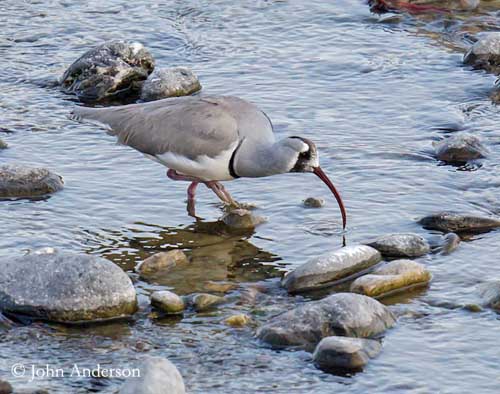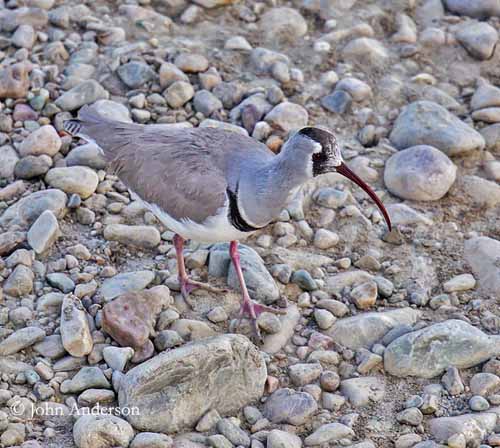
Fr: Bec-d’ibis tibétain
All : Ibisschnabel
Esp : Picoibis
Ital : Becco di ibis
Nd: Ibissnavel
Sd: Ibisnäbb
Photographers:
John Anderson
John Anderson Photo Galleries
Tom Merigan
Tom Merigan’s Photo Galleries
Text by Nicole Bouglouan
Sources:
HANDBOOK OF THE BIRDS OF THE WORLD Vol 3 by Josep del Hoyo-Andrew Elliott-Jordi Sargatal - Lynx Edicions - ISBN : 8487334202
SHOREBIRDS by Peter Hayman, John Marchant and Tony Prater – Christopher Helm – 1986 – ISBN: 0747014035
L’ENCYCLOPEDIE MONDIALE DES OISEAUX - Dr Christopher M. Perrins - BORDAS - ISBN: 2040185607
BirdLife International (BirdLife International
CREAGUS@Monterey Bay (Don Roberson)
Wikipedia, the free encyclopaedia
Ibisbill
Ibidorhyncha struthersii
Charadriiforme Order – Ibidorhynchidae Family
BIOMETRICS:
Length: 39-41 cm – Bill length: 7-8 cm
Weight: 270-320 gr
DESCRIPTION:
The Ibisbill is the only member of this family and a very uncommon wader of flat stony rivers of CS Asia. Both appearance and behaviour may be distantly related to oystercatchers (Haematopodidae) and avocets and stilts (Recurvirostridae).
The adult in breeding plumage has bluish-grey neck sides, mantle, upper back and breast. There are two breast bands, a narrow white line and below, a broader black band. Lower back, most wing-coverts, scapulars and tertials are brownish-grey, with blackish-tipped tertials. In flight, there is a conspicuous white wingbar. The rump is grey-brown with weak blackish barring. The tail is grey-brown too, with barred black outer webs of outer rectrices.
Rest of underparts is white with pale greyish-brown underwing-coverts, and black and white pattern on flight feathers.
On the head, crown, face, chin and upper throat are black. A narrow white line outlines this black pattern, from lower throat extending above the eye to backwards, following the black crown, but it does not meet on the nape.
The long, down-curved bill is bright red. The eyes are deep red. Legs and feet are pinkish-red. Each foot includes thee toes, with outer and middle toes connected by a small web which is lacking between middle and inner toes.
In non-breeding plumage, the black face is less uniformly black, with white-tipped feathers.

The female resembles male but she is slightly larger and has longer bill.
The juvenile is browner with less contrasted plumage pattern. On the upperparts, feathers are pale-edged. The bare parts are duller and paler.
VOICE: SOUNDS BY XENO-CANTO
The Ibisbill is usually silent outside the breeding season. During courtship displays, it utters a series of up to 40 loud, melodious and silvery notes, resembling that of the Eurasian Oystercatcher, but louder and more melodious. We can also hear a rapid, loud “tee-tee-tee-tee”.
Both calls are given during territorial behaviour or when the bird is alarmed or disturbed. But they are also heard during the displays.
HABITAT:
The Ibisbill breeds at high elevation, in flat-bottomed river valleys with slow-flowing water, on banks or islets formed with pebbles and rounded boulders. It can be found between 500 and up to 4000 metres of elevation.
It performs altitudinal movements in winter, down to 100 metres in places, but it occupies the same type of habitat.
RANGE:
The Ibisbill is found on stony riverbanks of the high plateau of Central Asia and the Himalayas, from Kazakhstan to NW China and southwards to NW India.
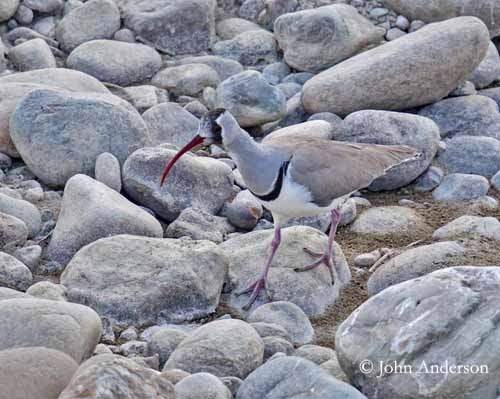
BEHAVIOUR:
The Ibisbill feeds on various insects and their larvae, crustaceans and small fish, the latter is mainly taken at lower elevation during winter. The main food includes aquatic insects during the breeding season.
This species is highly specialized, and the long, down-curved bill is used in three different ways for feeding, pecking, probing and raking.
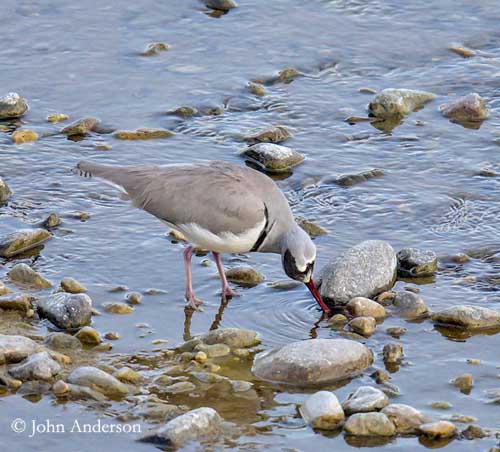
It pecks insects from water surface, often remaining in the same small area during three-four hours by the beginning or ends of rapids. This bird usually feeds alone and occasionally in pairs.
It probes into submerged stones with water at belly-level. The bill is inserted between all sizes shingles, and the bird moves about along the river edge.
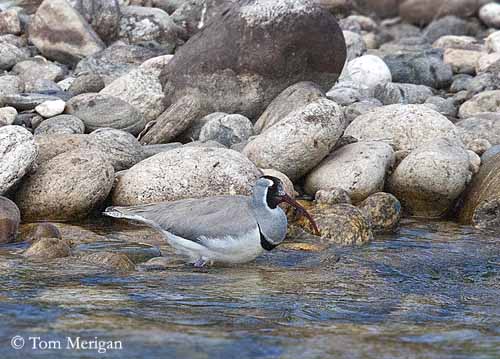
Raking is a different method. The Ibisbill tilts the head to one side and then, rakes with its bill from side to side through the pebbles. It disturbs invertebrates and pecks them up when they come to the surface.
These three methods are used according to weather conditions at high elevation. The aquatic insects can be affected by water temperatures, which also affect the feeding habits of the birds.
The Ibisbill is solitary breeder. However, the restricted suitable breeding sites often give the appearance of loose colonies. After the breeding season, in autumn and winter, they are usually solitary, but they can be seen also in pairs or in small groups. They may roost together on islets. They become more active and vocal when the breeding season is approaching. They take flight more often but usually, they prefer to cross rivers by swimming.
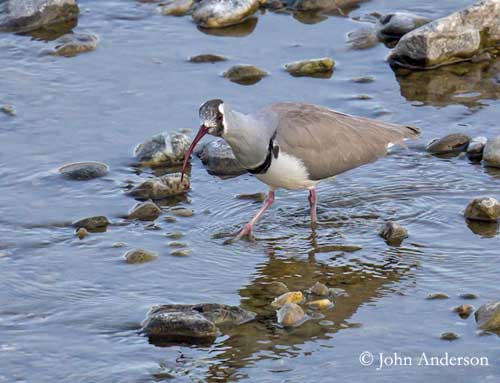
When disturbed, the Ibisbill moves the head nervously and repeatedly up and down. This display is performed during courtship too, accompanied with calls. The female responds by moving slowly towards the male. Then, she turns and stands motionless. The male may briefly simulate copulation, or eventually copulation occurs, followed by preening or foraging. During displays, a small crest is erected on the black rear crown.
The same behaviour is used to select a nest-site, and then, both birds make a rapid circling of the potential site.
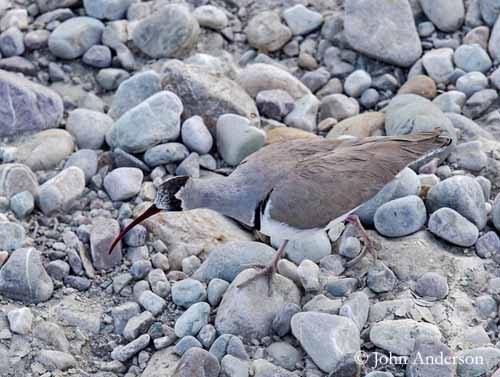
The Ibisbill performs altitudinal movements after breeding, but it remains within the breeding range where they move to lower elevations.
FLIGHT:
The Ibisbill has strong flight performed with fairly slow wingbeats. The head is held outstretched and slightly high during the flight.
REPRODUCTION:
The Ibisbill returns to the breeding grounds in March, and the laying starts end of April. This species is monogamous and territorial, and the territory is defended with aerial displays.
The nest is a depression on the ground, made in sandy shingle. It is sometimes lined with pebbles.
The female lays 4 greenish-grey eggs with brown markings. Both sexes incubate and take turns, but the length of this period is unknown and estimated about one month. At hatching, the chicks are covered in greyish down with darker markings. The bill is brownish and the size is 18 millimetres. One adult remains almost continuously with the chicks.
Weather conditions can be harsh, with snow even in May in Central Asia. The adults remain silent when they take turns and they approach the nest on foot.
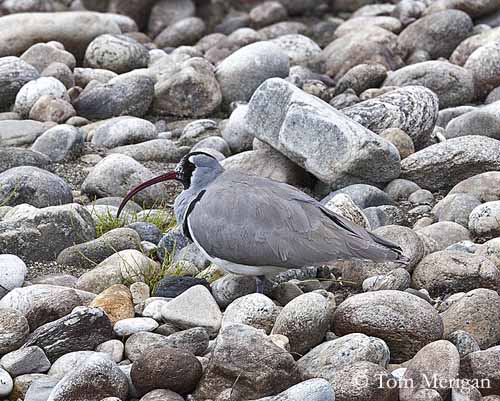
The female takes the chicks away from the nest as soon as they are dry. They are joined by the male and the family moves 100-200 metres away. The young can fly about 45-50 days after hatching.
When disturbed at nest, the adults lead the intruder away by uttering loud piping calls, or fly directly at the intruder before changing direction abruptly. Adults may also perform injury-feigning distraction display.
In response to a threat, the chicks remain sitting motionless among pebbles, and their colour allows them to be almost invisible.
After fledging, all members of the family remain together until the autumn.
The chicks can be preyed upon by the Red Fox, and the nests are at permanent risk of flooding, due to changes in water levels. The grazing sheep may sometimes use the river valley as passageways and the nests are trampled.
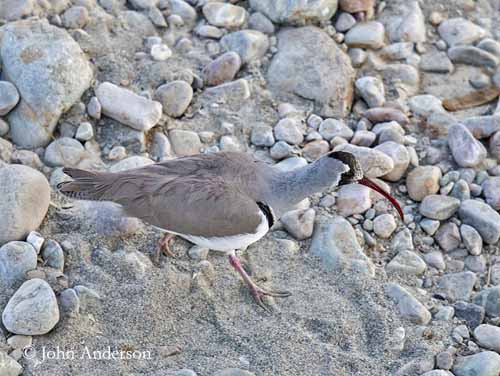
DIET:
The Ibisbill feeds on aquatic invertebrates including insects and their larvae and crustaceans, and also takes small fish.
It wades in water and feed by pecking, probing and raking.
PROTECTION / THREATS / STATUS:
The Ibisbill has wide range with sparse human populations. The habitat is limited but the species breeds in several protected areas in the Himalayas.
In spite of several threats such as habitat destruction, water levels, industrial use of gravels, nest trampling by sheep and human or tourist activities, this species is not currently threatened. The numbers are small and the birds occur only locally.
